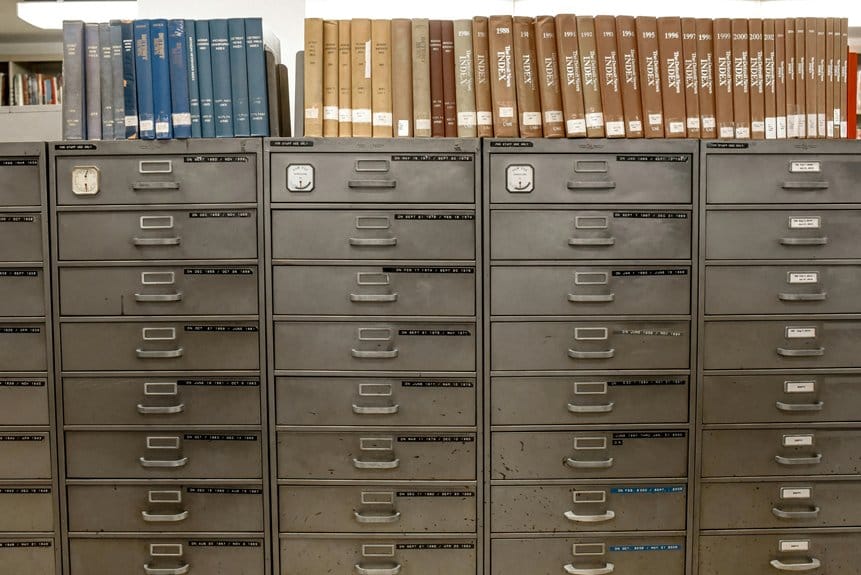Decentralized storage architecture fundamentally enhances data security by distributing encrypted files across multiple independent nodes in peer-to-peer networks. Advanced cryptographic protocols, including AES-256 encryption and Byzantine fault tolerance, protect data integrity while eliminating single points of failure. Implementation success stories from platforms like Filecoin and Storj demonstrate enterprise-grade reliability, with systems processing hundreds of petabytes while maintaining 99.95% uptime through sophisticated sharding mechanisms. Multi-factor authentication, granular access controls, and blockchain-based verification systems ensure robust security compliance with regulations like GDPR. The evolution of eco-friendly consensus models and enhanced compression techniques signals a transformative shift in secure data management solutions.
Understanding Decentralized Storage Architecture
Decentralized storage architecture represents a fundamental shift from traditional centralized storage systems by distributing data across multiple independent nodes within a peer-to-peer network. This approach implements various storage models that ensure data integrity through automated redundancy and sophisticated network topology designs. Each node operates autonomously while maintaining synchronization with the broader network through decentralized protocols.
The architecture incorporates multi-layered access controls and encryption methods to safeguard data throughout its lifecycle. Files are typically split into smaller segments, encrypted, and distributed across the network using advanced cryptographic algorithms. This fragmentation enhances security while enabling efficient data retrieval and reconstruction processes.
However, decentralized storage faces distinct scalability challenges as the network grows. System performance can be affected by factors such as network latency, node availability, and bandwidth constraints. To address these issues, implementations often utilize dynamic routing algorithms and intelligent caching mechanisms.
The architecture must balance security requirements with operational efficiency, implementing optimized protocols for data verification, node consensus, and recovery procedures. This framework ensures resilient storage capabilities while maintaining the core benefits of decentralization: enhanced security, reduced single points of failure, and improved data sovereignty.
Key Security Features and Benefits
The robust security infrastructure of decentralized storage systems encompasses multiple layers of protection that fundamentally reshape data security paradigms. Through advanced encryption protocols and distributed ledger technology, these systems ensure data integrity while maintaining high availability across geographically dispersed nodes.
Data redundancy mechanisms replicate information across multiple locations, significantly reducing the risk of data loss or system failures.
Access control and user authentication protocols form critical components of the security framework, implementing granular permissions and multi-factor verification to prevent unauthorized access. Privacy preservation features encrypt data at rest and in transit, while enabling users to maintain sovereign control over their information.
The architecture supports scalability solutions that can adapt to increasing storage demands without compromising security measures.
These systems adhere to compliance standards while offering enhanced protection against traditional security vulnerabilities. The combination of distributed storage, cryptographic security, and automated verification processes creates a resilient framework that significantly reduces attack surfaces.
Common Threats and Defense Mechanisms
Despite robust security features, decentralized storage systems face sophisticated attack vectors that require comprehensive defense strategies. Common threats include coordinated data breaches, network vulnerabilities exploiting consensus mechanisms, and malicious attacks targeting node infrastructure. These challenges necessitate multi-layered security protocols and advanced threat mitigation techniques.
To combat these threats, decentralized systems employ dynamic encryption methods, including asymmetric cryptography and zero-knowledge proofs. Access controls are implemented through smart contracts and cryptographic tokens, ensuring only authorized entities can retrieve or modify stored data.
Network security is enhanced through Byzantine fault tolerance protocols and distributed hash tables that prevent single points of failure. Additional defense mechanisms include regular security audits, automated threat detection systems, and granular permission management.
Storage nodes utilize reputation systems to identify and isolate compromised peers, while end-to-end encryption safeguards data during transit and storage. Advanced techniques such as data sharding and erasure coding further protect against unauthorized access and system failures.
These protective measures work in concert to maintain data integrity while preserving the decentralized nature of the storage network.
Real-World Implementation Success Stories
Successful implementations of distributed storage networks have demonstrated remarkable resilience and scalability in production environments. Notable examples include Filecoin's deployment across multiple continents, achieving data sovereignty while maintaining robust security protocols. The platform has processed over 150 petabytes of data through its decentralized architecture, showcasing significant cost efficiency compared to traditional cloud storage solutions.
Storj's implementation highlights user empowerment through its node operator program, where individuals contribute storage capacity while earning rewards. Their system has achieved 99.95% uptime while addressing scalability challenges through innovative sharding mechanisms.
IPFS's integration into enterprise systems demonstrates how technological innovations can overcome interoperability issues, enabling seamless data transfer across different platforms.
Sia Network's success in community engagement has resulted in over 2,000 active storage providers worldwide, contributing to environmental sustainability through optimized resource utilization. Their implementation of reed-solomon encoding ensures data integrity while reducing redundancy overhead.
These real-world applications have validated the feasibility of decentralized storage solutions, proving their capability to meet enterprise-grade requirements while maintaining security standards and operational efficiency.
Best Practices for Data Protection
Implementing robust data protection in decentralized storage systems requires adherence to multiple security layers and cryptographic protocols. Organizations must prioritize end-to-end data encryption, utilizing strong algorithms like AES-256 and ensuring proper key management throughout the data lifecycle.
Access control mechanisms should incorporate role-based permissions and multi-factor user authentication to prevent unauthorized access.
Compliance regulations, such as GDPR and HIPAA, necessitate regular security audits and documentation of data handling procedures. To maintain data integrity, organizations should implement blockchain-based verification systems and conduct periodic checksum validations.
Comprehensive backup strategies must include geographically distributed redundancy and automated versioning control.
Effective threat modeling helps identify potential vulnerabilities and attack vectors, enabling proactive security measures. This should be coupled with a well-documented incident response plan that outlines procedures for breach detection, containment, and recovery.
Regular security training for system administrators and end-users is essential to maintain awareness of emerging threats and proper security protocols. Organizations should also implement continuous monitoring systems to detect and respond to potential security incidents in real-time.
Future of Decentralized Storage Systems
As decentralized storage systems continue to evolve, emerging technologies like quantum-resistant cryptography and advanced consensus mechanisms are reshaping the landscape of distributed data management.
These innovations address critical scalability challenges while ensuring data integrity across expanding networks. The integration of zero-knowledge proofs and sharding protocols promises to enhance both performance and security in future implementations.
Market trends indicate a shift toward hybrid storage solutions that combine on-chain and off-chain data management, particularly in enterprise environments.
This evolution coincides with increasing regulatory implications, as jurisdictions worldwide develop frameworks for distributed data governance. The industry must navigate complex compliance requirements while maintaining decentralization principles.
User adoption rates are expected to accelerate as interfaces become more intuitive and cross-chain interoperability improves.
However, environmental impact concerns regarding energy consumption in consensus mechanisms are driving innovation in more sustainable protocols.
The next generation of decentralized storage systems will likely incorporate proof-of-stake variations and energy-efficient validation methods.
These advancements, coupled with enhanced data compression and intelligent routing algorithms, will be crucial for establishing decentralized storage as a mainstream solution for secure data management.
Frequently Asked Questions
How Much Does Decentralized Storage Cost Compared to Traditional Cloud Storage Solutions?
Cost comparison between decentralized and traditional storage varies significantly, with pricing models ranging from $1-5/TB/month for decentralized solutions versus $20-25/TB/month for mainstream cloud providers.
Can Decentralized Storage Systems Handle Streaming Media and Real-Time Data Effectively?
Decentralized networks can support streaming media through enhanced protocols, though streaming performance may vary. Data accessibility depends on network density and node distribution, requiring optimized content delivery mechanisms for real-time operations.
What Happens to Stored Data if the Decentralized Network Experiences Significant Node Losses?
Data redundancy protocols maintain multiple copies across nodes, ensuring file survival despite significant node losses. Node resilience mechanisms automatically redistribute data, preserving integrity through distributed replication and self-healing processes.
Are There Geographical Restrictions or Regulations Affecting Decentralized Storage Implementation?
Geographical regulations and data sovereignty laws impose jurisdictional constraints on data storage locations, requiring compliance with regional protocols and necessitating strategic node placement to meet cross-border data transfer requirements.
How Can Businesses Transition From Centralized to Decentralized Storage Without Disrupting Operations?
Implement phased data migration strategies with parallel systems running initially. Deploy comprehensive employee training programs while maintaining security protocols. Gradually transfer workloads and validate data integrity throughout the transition process.
Conclusion
Decentralized storage systems represent a significant advancement in data security architecture, offering robust protection through distributed networks and cryptographic protocols. The implementation of blockchain-based verification, redundant storage mechanisms, and zero-knowledge proofs has demonstrated measurable improvements in data integrity and breach prevention. As quantum computing emerges, decentralized storage protocols will continue evolving, integrating advanced encryption standards and automated security responses to maintain resilient data protection in an increasingly complex threat landscape.





